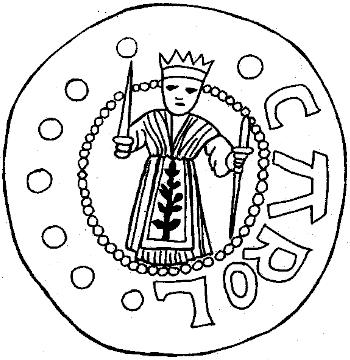King Charlemagne in Royal Apparel

This unique coin is from sometime between 742 and 814 A.D. and depicts Charles the Great, also known as Charlemagne, arrayed in his royal apparel. Matthew Brown describes it thus:
…wearing a crown, a pleated robe, and an apron that is decorated with a tree. The king also holds the sword, which in ancient times was regarded as a royal weapon. ((Matthew Brown, The Gate of Heaven, 127.))
Diane Wirth, a writer and lecturer on Mesoamerican iconography, describes the design on this apron as the “Tree of Life” ((Diane Wirth, “The King and the Tree of Life: Evidence of Pre-Columbian Contact,” 2003 BMAF Conference, <http://www.bmaf.org/page.php?cmd=view&id=57>.)). Brown corroborates when he says that the king himself, in the ancient Near East, was often seen as a “personification of that tree” ((Matthew Brown, Girded About with a Lambskin, FARMS, <http://farms.byu.edu/display.php?id=149&table=jbms>.)).
Brown continues that “Since the king of Israel was considered to be the personification of Adam…, we might ask whether his apron somehow imitated the fig leaf apron that was worn by Adam (see Genesis 3:7)” ((Matthew Brown, The Gate of Heaven, 150)). Furthermore, “ancient Hebrew legends . . . taught that the tree of knowledge of good and evil was a fig tree and it was from this tree’s leaves that Adam constructed his apron” ((Matthew Brown, Girded About with a Lambskin, FARMS, <http://farms.byu.edu/display.php?id=149&table=jbms>.)).
Another image of Emperor Charlemagne (see figure 297) likewise shows him wearing such plantlife iconography, whether trees or leaves, upon his breast ((Paul Lacroix, Manners, Custom and Dress During the Middle Ages and During the Renaissance Period, <http://www.gutenberg.org/files/10940/10940-h/10940-h.htm>.)).

 Today a
Today a